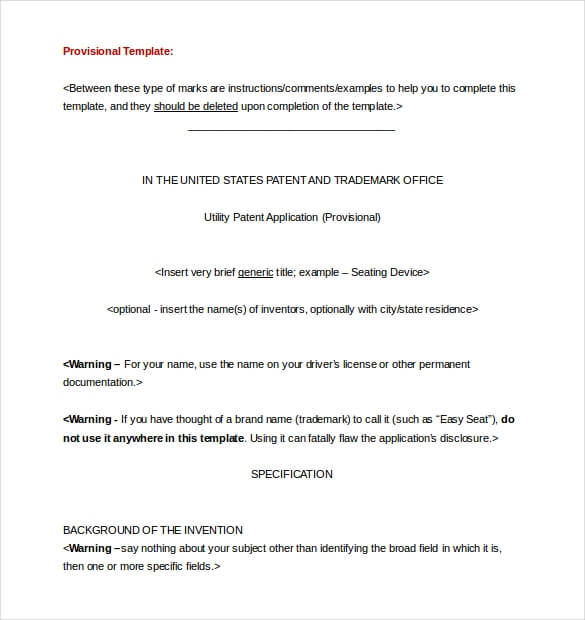Table of Contents
- What are provisional patents?
- What is the application process for a provisional patent?
- How much do provisional patents cost?
- What are the benefits of provisional patents?
- Are there any downsides to provisional patents?
- Key facts about provisional patents
What are provisional patents?
A provisional patent safeguards an inventor’s position in the queue for a USPTO patent review and presents sufficient information in order to distinguish the inventor’s work so that someone else’s application will not take priority.
What’s more, a provisional patent permits the inventor to use the phrase “patent pending” to describe it. This phrase informs anyone that is considering copying the inventor’s work that, if the inventor is ultimately granted a patent, the potential infringer might be liable for patent infringement from the filing date of the provisional patent application.

What is the application process for a provisional patent?
A provisional patent application is less of a complicated process compared to a full application. The fundamental necessities are drawings and a description of the invention, the inventor(s) involved, and the fee. Although a provisional patent application is comparatively straightforward, one should ensure it is accurate enough so the USPTO can correctly recognize the work.
The inventor can prepare and submit the provisional patent application themselves; alternatively, the individual can seek legal assistance.
It is worth noting that a provisional patent application does not indeed grant any legal intervention that prevents other people from copying the invention. With this in mind, once the provisional application has been submitted and an early filing date has been established, the next steps should be taken in order to proceed with a full, nonprovisional patent application.
In the event of the disapproval of a full nonprovisional patent application and the subsequent expiry of the provisional patent, one may review and revise the full application and apply for it again. If the USPTO rejects the application twice, the decision can be appealed.
How much does a provisional patent cost?
At the time of writing this article, depending on the size of the entity, filing a provisional patent application with the USPTO will cost between $70-$280. After the successful filing of the provisional patent application, the entitlement of describing the invention as “patent pending” for the next 12 months can begin.
What are the benefits of provisional patents?
There are numerous benefits to filing a provisional patent application. Here are a few to consider:
- One can write one’s own application.
- The associated costs are a lot lower than filing a nonprovisional patent application.
- After the successful filing of the provisional patent application, the invention may be described as “patent pending” for the next 12 months.
- During the “patent pending” period, one can test the market by approaching manufacturers for quotations, potential buyers, and marketing specialists, to name but a few.
- During this time, one can also continue to build and test several prototypes, which can then lead to valuable discoveries.
- By waiting to file a nonprovisional application, one might run the risk of no longer being the first inventor to file.
While in the “patent pending” period, we would always recommend that one should continue searching for prior art. Investigate the claims of the patents that already exist and keep an eye out for missing elements, such as manufacturing methods. Many ideas are patented with no specific production ideas in place.
Find out more about how to conduct a prior art search here
If the inventor also knows how to produce the invention, additional intellectual property filings for the manufacturing techniques can also be applied for. The inventor could wind up finding a system or method that allows them to produce their concept in a more efficient manner, and this is an extremely effective way to protect an asset.
Are there any downsides to provisional patents?
The one-year time limit for filing a provisional patent application cannot be extended. From a legal point of view, if one does not file a nonprovisional application within a year, one will lose the filing date and the benefits that come with it.
It is also worth noting that many other countries typically base the filing time for a nonprovisional application on the provisional patent application’s filing date.
Therefore, an international application might need to be filed at the same as a nonprovisional application, which is benefiting from a provisional patent application in the United States.
Additionally, in the event of a provisional patent application not sufficiently explaining everything claimed in the subsequent nonprovisional application, the elements that are added to the nonprovisional application may not reflect the filing date of the provisional patent application, this could then affect the patentability.
Key facts about provisional patents
- A provisional patent application is valid for one year.
- A provisional patent application cannot be extended or renewed.
- A provisional patent application cannot be filed for a design.
- The USPTO does not examine provisional patent applications.
- Provisional patent applications are not subject to USPTO prior art searches.
- Provisional patent applications are reviewed by the USPTO to ensure they meet the minimum filing requirements.
- The USPTO does not publish provisional patent applications (unless they are claimed as priority in a later-published or issued nonprovisional patent application).
- The term “patent pending” can be used for the one-year term of a provisional patent application.
Prior art searches
As mentioned earlier, conducting a prior art search is really important. The first port of call should always be Patent Search by Patentcloud.
Start searching today with a 7-day free trial of Patent Search


